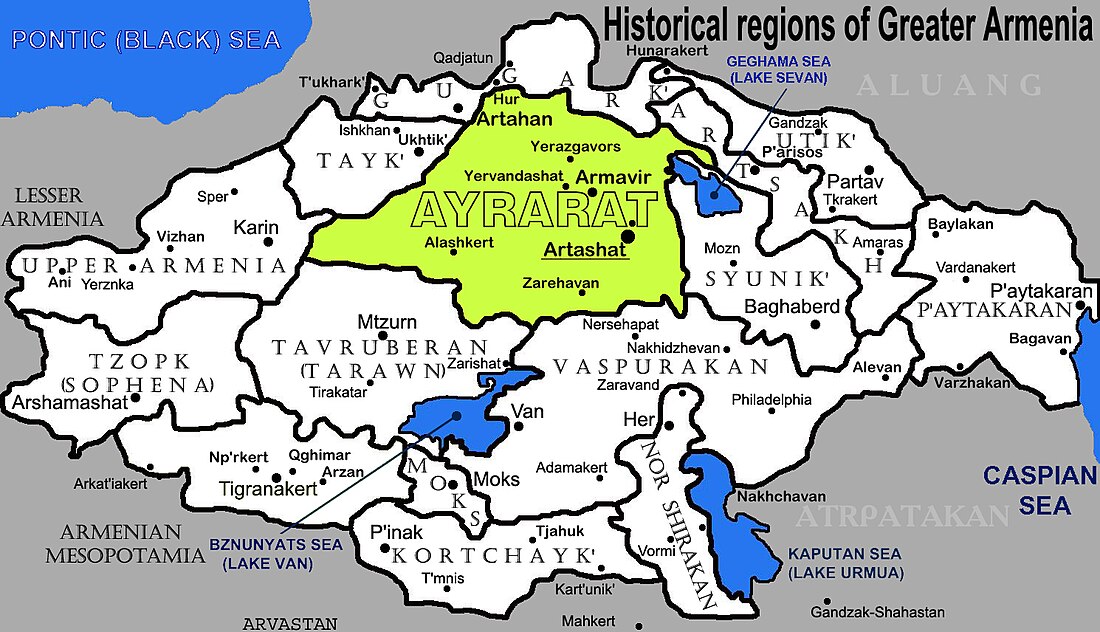Ayrarat
Historical province of Armenia From Wikipedia, the free encyclopedia
Ayrarat (Armenian: Այրարատ) was the central province of the ancient kingdom of Armenia, located in the plain of the upper Aras River. Most of the historical capitals of Armenia were located in this province, including Armavir, Yervandashat, Artashat, Vagharshapat, Dvin, Bagaran, Shirakavan, Kars and Ani (the current capital of Armenia, Yerevan, is also located on the territory of historical Ayrarat).
| Այրարատ | |
|---|---|
| Province of the ancient kingdom of Armenia | |
 | |
| Capital | Artashat |
| History | |
• Artaxias I declaring himself independent | 189 BC |
| 650 AD | |
Name
The name Ayrarat is clearly connected with Uruatri/Urartu and the biblical Ararat, and perhaps also with the Alarodians mentioned by Herodotus.[1][2] It is not used by any of the classical Greek and Roman authors who write about Armenia, which suggests that it was a purely local name used to refer to the central lands of Armenia.[1][2] Robert H. Hewsen does not rule out the possibility that Armenians applied the name to the great plain surrounding Mount Masis after converting to Christianity in the early fourth century and identifying the biblical Ararat with Masis.[3] If this is the case, then Ayrarat may be identical with the Araxēnon Pedion ("Araxes plain") mentioned by Strabo.[4]
The ultimate etymology of the names Urartu, Ayrarat, and Ararat is not known for certain. In the Armenian tradition, Ayrarat and the Ararat plain are associated with the legendary Armenian king Ara the Handsome.[5]
The province is also referred to in Armenian sources as the Mijnashkharh Hayotsʻ ("central province of Armenia") or as the Glukh erkrin Hayotsʻ ("head province of Armenia").[6] During the Arsacid period, Ayrarat referred to, in its narrowest sense, the royal domain consisting of the Ararat plain and its adjacent districts.[7] The author of the seventh-century geography Ashkharhatsʻoytsʻ used the term Ayrarat to refer to a much larger territory.[2] The name Ayrarat gradually fell out of use after the fall of the Bagratid Kingdom of Armenia and the conquest of Armenia by the Seljuks in the eleventh century.[4]
Districts

The seventh-century Ashkharhatsʻoytsʻ attributed to Anania Shirakatsi depicts Ayrarat as a very large province with 22 districts, but this is probably based on the new administrative divisions created after the Byzantine-Persian partition of Armenia in 591.[2]
| District name | Capital | Other large cities | Additional information |
|---|---|---|---|
| Shirak | Ani | Shirakavan, Kumayri, Shirakashat | |
| Aragatsotn | Oshakan | Vagharshapat, | |
| Nig | Kasagh (Aparan) | Bjni | |
| Varazhnunik | Hovk (Dilijan) | ||
| Vostan Hayots | Artashat, Dvin | Kakavaberd | |
| Vanand | Kars | ||
| Masyats-Votn | Tsolakert | ||
| Kogovit | Darevnitsberd | ||
| Basean | Also known as Phasiane | ||
| Bagrevand | Alashkert | ||
| Chakatk | Koghb | ||
| Abeghyan | Mzhnkert | Also known as Abelyankq, Abelunk Myus, Abeghank, Abeghenk, Abeghenk Myus, and Abeghunik. | |
| Havnunik | |||
| Arshanunik | Yervandashat, Bagaran, Yervandakert,
Artagers |
Also known as Yeraskhadzor. | |
| Tsaghkotn | Tateon | ||
| Arats | Arats | Arats | |
| Urtsadzor | Urts | ||
| Kotayk | Yerevan | Yerevan | |
| Mazaz | Artavazdakan | ||
| Ashotsk | Ashotsk | ||
| Upper Tashir | Tandzut | ||
| Gabeghyank | Kaghzvan |
See also
References
Bibliography
Wikiwand in your browser!
Seamless Wikipedia browsing. On steroids.
Every time you click a link to Wikipedia, Wiktionary or Wikiquote in your browser's search results, it will show the modern Wikiwand interface.
Wikiwand extension is a five stars, simple, with minimum permission required to keep your browsing private, safe and transparent.
